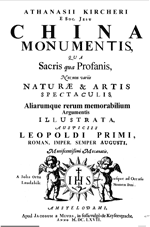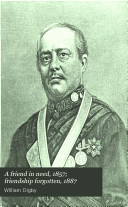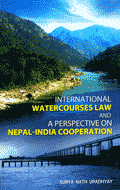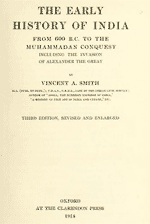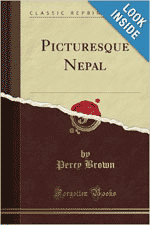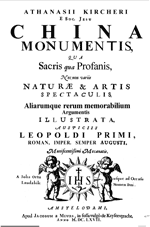 Athanasius Kircher, China Monumentis [Amsterdam: Jaco Meurs, 1667]
Athanasius Kircher, China Monumentis [Amsterdam: Jaco Meurs, 1667]
The Year 1667 is not a politically remarkable year in the history of Nepal. But it is in this year that King Pratap Malla (reigned 641-74) is said to have built Rani Pokhari (Queen’s Pool) in Kathmandu to console his queen over the death of their son who was trampled by an irate elephant. Similarly, it was the year when an important book on China with some references on Necbal[Nepal] was published.
The book in the context is China Monumentis [Amsterdam: Jaco Meurs, 1667]. Written in Latin by Athanasius Kircher (1602-1680), a German Jesuit scholar with forty major works to his credit, the book aimed at providing information to the Europeans about the Chinese Empire. As Kircher had interest in Sinology, among many other subjects of his choice, he ventured to study China and also a few of its neighbouring countries as far as it was possible for him at the time. The work is based on Chinese monuments, both sacred and profane, and what he claims to be diverse wonders of nature and of art. The book which was pursued with a missionary zeal was translated from the original Latin edition into English in 1986 – after 319 years of its publication – by Dr. Charles D. Van Tuyl.
China Monumentis has wealth of information on China. Some of them have already been proved imaginary and outdated in view of new findings. What is important for Nepalese readers is the information that the book has on Nepal. They were passed on to the author by Johannes Grueber, a young Belgian missionary who had been living in Peking since1656 as a professor of mathematics. Grueber traveled through Cadmendu in 1661, on his way back to Rome accompanied by Albert d’Orville, another missionary from Austria. They were visiting Cadmendu from the imperial Chinese Observatory in Peking via Lhasa, seeking a land route to India. This difficult route was chosen because they were blockaded by the Dutch rulers at Macao, wherefrom they could safely sail home. Thus turned this restriction into an opportunity to travel overland through China, Tibet, Nepal, India, and thence onward to Rome.
Grueber described the terrors of journey from Lhasa to the foot of Mount Langur [not clear which mountain it is] that took them four days on the foot. “At the summit of Langur, the highest mountain of all, travellers is scarcely able to breathe because of the thinness of the atmosphere. One cannot cross the mountain without danger to the life from the noxious exhalations of certain plants in the summer. Neither vehicles nor beasts of burden can cross the mountain because of the dreadful precipices and the huge boulders.” The whole journey took about a month in order to reach Cuti – a township (today known as Nyalam to Tibetans) which fell under the Kingdom of Nepal at that time.
Although this mountainous region is difficult to cross, it has been emphasized that the nature has provided, from her abundance, hot and cold springs which burst forth from the caverns of the mountain, as well as an abundance of fish for men, and pastures for “beasts of burden.” Gruber also calculates that this is probably the tract which Ptolomy calls a range of the Caucasus mountains. The distance between Cuti to Nesti (also falling under Nepal) is five days, and from Nesti to Cadmendu has been described as six days. At this point, all the people living in Nesti have been described as “enveloped in the darkness of idolatry without any sign of the Christian faith.” “There is, however, an abundance of all the necessities of life, so that in some places thirty or forty chickens are sold for one scutum.” “Nothing was missing for the sustenance of life, except for faith in Christ, for all are wrapped up in pagan darkness.”
At the time when Johanne Grueber and Albert d’Orville entered Nepal, Pratap Malla was the King of Kantipur. He was a powerful ‘pagan’ king and led a prosperous kingdom. His kingdom had monopoly over trade with Tibet. Even though the King has been described as ‘pagan’, he still has been characterized as “not unfriendly to Christian law.” The king has also been reported to have been fascinated by the telescope and other scientific instruments that the visitors carried along, which he had never heard of before. That was also interpreted as the reason why he wanted the visitors to stay in Cademendu and do their missionary works.
Talking about the customs of the people of Cuti and Nesti (the later township does not seem to be known by that name today), the author notes: “They have another custom here, fearsome in its barbarism. When sick people are near death and there is no hope for their recovery, they are thrown out of the house into the ditches of the field full of corpses. There, being exposed to all injuries of nature, these die without any acts of devotion or lamentation. After dying, these are left to be devoured by birds of prey, wolves, dogs, and other creatures. They persuade themselves that it is a uniquely glorious monument for the dead to obtain a sepulcher in the stomachs of living animals.” The visitors find the women of this new country not only ugly but also more like devils than humans. Going further, it has been stated that for some religious reasons, Nepalese people never wash themselves with water but only with totally rancid oil. Moreover, besides exhaling an intolerable stench, they are so stained by the oil that you would call them ghouls and not humans.
According to the author, from Cadmendu it is only a half day’s journey to the city called Baddan (Patan) which is the seat of the whole Kingdom of Nepal. At a five days journey from Necbal lies the town of Hedonda, a colony of the kingdom of Maranga. From Hedonda it is a journey of eight days to Mutgari [Motihari] which is the first city of Mogor [Mughal] empire. In the east of Mogor, one finds the kingdom of Necbal, “which can almost be called an empire because of the strength and power of the kings. It is well provided with everything necessary for living pleasurably.” However, there is nothing in the book which gives some light on the riches that the visitors had seen in this country.
The book contains illustrations of the dress of women of the Tanguth (a part of modern Tibet) Kingdom and Cuti, and of the capital of the Kingdom of Necbal. The faces of Nepal show Aryan as well as Newar – the former bearing an earlier version of Khukuri on his waist. There is one “many-headed idol” in the illustration by Fr. Grueber. Nevertheless, the visitors described this country as the Tartar kingdom of Nepal.
Charles D. Van Tuyl has claimed that “for over two hundred years, Kircher’s China Illustrata was probably the single most important written source for shaping the Western understanding of China and its neighbors.” Therein lies the importance of this book.
